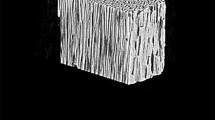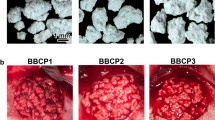Abstract.
Synthetic porous hydroxyapatite (HA) is commonly used as a bone substitute for bone defects which, previously, would have been treated by autogenous bone grafting. HA has been thought to be a nonbiodegradable material that remains as it is implanted. However, after long-term follow-up, some authors report that the margin of implanted HA blocks or granules is absorbed, suggesting that HA is biodegradable. We experienced a patient in whom synthetic HA blocks implanted in a bone defect of the ilium after the harvesting of full-thickness bone for grafting were extensively absorbed and replaced by newly formed bone 6 years and 7 months after the implantation. Therefore, we conclude that HA is biodegradable. Sintering temperature, porosity, and pore diameter seem to influence the biodegradability of HA.
Similar content being viewed by others
Author information
Authors and Affiliations
Additional information
Received: January 25, 2001 / Accepted: April 10, 2001
About this article
Cite this article
Goto, T., Kojima, T., Iijima, T. et al. Resorption of synthetic porous hydroxyapatite and replacement by newly formed bone. J Orthop Sci 6, 444–447 (2001). https://doi.org/10.1007/s007760170013
Issue Date:
DOI: https://doi.org/10.1007/s007760170013




